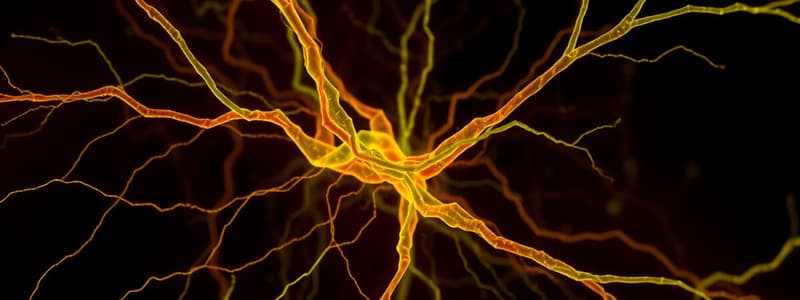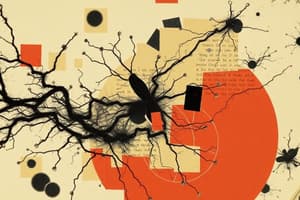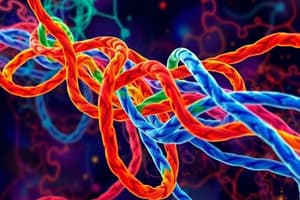Podcast
Questions and Answers
What is the diameter of actin filaments?
What is the diameter of actin filaments?
- 15 nm
- 5 nm
- 10 nm
- 7 nm (correct)
Which end of the actin filament is referred to as the plus end?
Which end of the actin filament is referred to as the plus end?
- The stubby end
- The tapered end
- The pointed end
- The barbed end (correct)
What happens to ATP after actin polymerizes?
What happens to ATP after actin polymerizes?
- It binds to other proteins for stability.
- It is converted to ADP and releases energy. (correct)
- It triggers actin filament contraction.
- It remains unchanged in the filament.
How does the hydrolysis of ATP affect actin polymerization?
How does the hydrolysis of ATP affect actin polymerization?
Which of the following statements is true about actin's catalytic machinery?
Which of the following statements is true about actin's catalytic machinery?
What role does ATP hydrolysis play in the actin polymerization cycle?
What role does ATP hydrolysis play in the actin polymerization cycle?
Which of the following structures do actin filaments form?
Which of the following structures do actin filaments form?
Which protein complex is essential for the nucleation of new actin filaments?
Which protein complex is essential for the nucleation of new actin filaments?
What is required for the activation of the Arp2/3 complex?
What is required for the activation of the Arp2/3 complex?
How do actin-binding proteins influence actin polymerization?
How do actin-binding proteins influence actin polymerization?
After ATP is hydrolyzed, what happens to older actin filaments?
After ATP is hydrolyzed, what happens to older actin filaments?
Which protein is involved in the recruitment of free actin to the Arp2/3 complex?
Which protein is involved in the recruitment of free actin to the Arp2/3 complex?
What initiates the polymerization of daughter filaments from the mother F-actin filament?
What initiates the polymerization of daughter filaments from the mother F-actin filament?
What effect does the strain from cofilin binding have on actin filaments?
What effect does the strain from cofilin binding have on actin filaments?
What is the function of the cell cortex made of actin filaments?
What is the function of the cell cortex made of actin filaments?
How does the mutation of filamin in melanoma cells affect their morphology?
How does the mutation of filamin in melanoma cells affect their morphology?
What structural feature is characteristic of the leading edge of a migrating cell?
What structural feature is characteristic of the leading edge of a migrating cell?
What role does filamin serve in the context of actin filaments?
What role does filamin serve in the context of actin filaments?
What is the primary feature observed in cancer cells with disrupted filamin function?
What is the primary feature observed in cancer cells with disrupted filamin function?
What type of cellular structure is seen at the leading edge of a crawling cell?
What type of cellular structure is seen at the leading edge of a crawling cell?
In the actin filaments of lamellipodia, how are the filaments arranged?
In the actin filaments of lamellipodia, how are the filaments arranged?
What angle does the daughter actin filament branch off from the mother filament?
What angle does the daughter actin filament branch off from the mother filament?
What effect does profilin have on G-actin?
What effect does profilin have on G-actin?
What mechanism is primarily responsible for actin dynamics exhibiting treadmilling behavior?
What mechanism is primarily responsible for actin dynamics exhibiting treadmilling behavior?
How do formins contribute to actin polymerization?
How do formins contribute to actin polymerization?
What role do capping proteins play in filament length regulation?
What role do capping proteins play in filament length regulation?
What characteristic of profilin allows it to induce a more open conformation in actin?
What characteristic of profilin allows it to induce a more open conformation in actin?
How does cofilin affect the actin lattice in the ADP state?
How does cofilin affect the actin lattice in the ADP state?
What distinguishes filopodia from lamellipodia in terms of actin structure?
What distinguishes filopodia from lamellipodia in terms of actin structure?
What is the primary role of actin filament polymerization at the plus ends?
What is the primary role of actin filament polymerization at the plus ends?
Which protein functions as an actin nucleator in filament formation?
Which protein functions as an actin nucleator in filament formation?
How does cofilin contribute to actin filament dynamics?
How does cofilin contribute to actin filament dynamics?
What is the significance of the angle at which the daughter filament grows from the mother filament?
What is the significance of the angle at which the daughter filament grows from the mother filament?
What triggers disassembly of aged mother actin filaments?
What triggers disassembly of aged mother actin filaments?
What determines the formation of different actin structures based on cell type?
What determines the formation of different actin structures based on cell type?
Which small GTPase is NOT mentioned in connection with actin structure formation?
Which small GTPase is NOT mentioned in connection with actin structure formation?
Which process is coordinated with F-actin dynamics during neuronal cell migration?
Which process is coordinated with F-actin dynamics during neuronal cell migration?
Flashcards
Actin Filament Structure
Actin Filament Structure
Thin, flexible protein threads (7nm diameter) with a polarized structure (plus/barbed end and minus/pointed end) and a helical chain of actin monomers.
Actin Polymerization
Actin Polymerization
Process of actin monomers binding together to form a filament, initially in the ATP-bound state, with hydrolysis of ATP to ADP leading to a conformational change.
Actin Subunits
Actin Subunits
Individual actin monomers that make up the filament. Actin has four subdomains, with 1 and 3 similar, and ATP binding at the center.
Actin Cytoskeleton Function
Actin Cytoskeleton Function
Signup and view all the flashcards
ATP Hydrolysis in Actin
ATP Hydrolysis in Actin
Signup and view all the flashcards
Actin polymerization
Actin polymerization
Signup and view all the flashcards
Actin depolymerization
Actin depolymerization
Signup and view all the flashcards
Arp2/3 complex
Arp2/3 complex
Signup and view all the flashcards
Actin-binding proteins
Actin-binding proteins
Signup and view all the flashcards
Filopodia/Lamellipodia
Filopodia/Lamellipodia
Signup and view all the flashcards
ATP in Actin
ATP in Actin
Signup and view all the flashcards
WASP protein
WASP protein
Signup and view all the flashcards
Nucleation of Actin
Nucleation of Actin
Signup and view all the flashcards
Actin Branching
Actin Branching
Signup and view all the flashcards
Profilin's Role
Profilin's Role
Signup and view all the flashcards
Actin Treadmilling
Actin Treadmilling
Signup and view all the flashcards
ATP Hydrolysis in Actin
ATP Hydrolysis in Actin
Signup and view all the flashcards
Formins & Filopodia
Formins & Filopodia
Signup and view all the flashcards
Capping Proteins
Capping Proteins
Signup and view all the flashcards
Cofilin & ADP-actin
Cofilin & ADP-actin
Signup and view all the flashcards
Arp2/3 & Lamellipodia
Arp2/3 & Lamellipodia
Signup and view all the flashcards
Actin Filament Strain
Actin Filament Strain
Signup and view all the flashcards
Cell Cortex
Cell Cortex
Signup and view all the flashcards
Filamin
Filamin
Signup and view all the flashcards
Metastatic Melanoma
Metastatic Melanoma
Signup and view all the flashcards
Membrane Blebs
Membrane Blebs
Signup and view all the flashcards
Lamellipodium
Lamellipodium
Signup and view all the flashcards
Actin Filament Orientation
Actin Filament Orientation
Signup and view all the flashcards
Actin Y-Junctions
Actin Y-Junctions
Signup and view all the flashcards
Actin Filament Growth
Actin Filament Growth
Signup and view all the flashcards
ARP complex
ARP complex
Signup and view all the flashcards
Capping protein function
Capping protein function
Signup and view all the flashcards
Cofilin's role
Cofilin's role
Signup and view all the flashcards
Actin filament organization control
Actin filament organization control
Signup and view all the flashcards
Growth cones
Growth cones
Signup and view all the flashcards
Microtubules and F-Actin coordination
Microtubules and F-Actin coordination
Signup and view all the flashcards
GTPase Regulation
GTPase Regulation
Signup and view all the flashcards
Study Notes
Exam 3 Information
- Exam 3 is next Thursday, November 14th
Cytoskeleton 3: Actin
- This lecture investigates actin, its structure, dynamics, regulators, the biological structures it forms, and how cells use the actin cytoskeleton.
- Objectives:
- Draw a cartoon of actin filament, highlighting polarity, dynamics, and the role of ATP.
- Discuss G-actin, F-actin, and how factors regulate F-actin nucleation, structure, and dynamics.
- Discuss the effects of various drugs that affect the actin cytoskeleton.
- Describe various cellular processes that require various actin structures.
- Compare and contrast the structure and function of various F-actin network structures.
Actin Cytoskeleton
- Actin filaments allow cells to adopt a variety of shapes and perform specific functions.
- Examples of structures include villi, contractile bundles, sheet-like and finger-like protrusions, and contractile rings.
Actin Filaments
-
Thin, flexible protein threads
-
7 nm in diameter
-
Less rigid than microtubules
-
Polarized: fast-growing plus (barbed) end and slow-growing minus (pointed) end
-
Structure:
- Actin molecule
- Pointed end
- Barbed end
- 37 nm
- Diameter 7 nm
- Two protofilaments
- Short pitch
- Long pitch
- Right-handed twist
-
Basic subunit is a single actin monomer that polymerizes into a helical chain.
-
Unlike microtubules, actin binds to ATP.
-
Interactions within the filament and between other protofilaments (short and long pitch interactions).
Actin Structure (ATPase)
- Actin has four subdomains.
- Subdomains 1 and 3 are similar.
- ATP binds at the center of the molecule.
- This contrasts with the GTP binding site on Beta-tubulin, located between the beta and alpha subunits.
- The ATP catalytic machinery is entirely within the actin protein.
- Hydrolysis is activated through allostery when actin polymerizes.
- Subdomains 1 and 2 face outward, while subdomains 3 and 4 face inward.
- G-actin polymerizes in the ATP-bound state.
- Actin hydrolyzes ATP to ADP; this results in a conformational change, weakening actin-actin contacts, and can lead to minus end depolymerization.
Actin Polymerization/Depolymerization
- Actin exhibits a similar polymerization and depolymerization cycle as microtubules, but with differences:
- Monomeric actin binds to ATP and polymerizes at the plus end.
- Upon polymerization, actin's endogenous ATPase activity cleaves ATP to ADP.
- ATP hydrolysis can be thought of as a molecular "clock"—older actin filaments with ADP are unstable and disassemble from the minus end.
Tubulin Versus Actin (Key Differences)
- Tubulin is a heterodimer
- Requires GTP for polymerization
- Residues that contribute to hydrolysis are supplied by longitudinal lattice mates
- GTP hydrolysis causes minor conformational changes
- 13 protofilaments (straight)
- Dynamics occur at the MT plus end
- Actin is a monomer
- Requires ATP for polymerization
- Residues that contribute to hydrolysis are supplied by the monomer
- ATP hydrolysis causes conformational changes
- 2 protofilaments (right-handed twist)
- Grows at the barbed end (plus end), and depolymerizes at the pointed end (minus end)
Actin Network Structures
- Actin can form filopodia and lamellipodia.
- Formation, regulation, and dynamics of these networks are regulated by distinct sets of actin-binding proteins.
- Example proteins include Ena/VASP, Arp2/3 and Formin.
Actin Binding Proteins (Illustrated in Green)
- Actin is induced to form various structures based on its interaction with actin-binding proteins and its own set of motor proteins.
- Example proteins include bundling proteins, severing proteins, cross-linking proteins, and capping proteins.
- Proteins regulate the type of actin network locally formed in regions of the cell, as well as the dynamics of the network.
Actin Nucleation (Arp2/3)
- Arp2/3 complex nucleates actin filaments at an angle from a mother filament.
- Daughter actin filaments grow at a roughly 70-degree angle from the mother filament.
- The Arp2/3 complex recruits Wasp-Profilin-Actin complexes.
- This recruitment initiates the nucleation and polymerization into daughter filaments.
- The Arp2/3 network is mainly located in lamellipodia.
Actin Nucleation (Continued)
- The Arp2/3 complex activation requires the full complex and the necessary factors (Actin, ATP and WASP)
- In the lamellipodium, Arp2/3 complex activates actin filaments that grow from mother filaments at an angle of approximately 70°.
- This process is regulated by GTPases such as Rho, Rac, or Cdc42.
Actin Sequestering (Profilin)
- Profilin binds to free ADP-bound G-actin and induces nucleotide exchange
- Profilin has a higher affinity for ATP-bound G-actin
- Actin hydrolyses ATP to ADP
- Dissociation and depolymerization occurs at the minus end – overall creating the treadmilling behavior of actin dynamics
- Actin has conformational changes due to ATP hydrolysis
- The ATP-bound state is slightly opened relative to the ADP state. These conformational changes affect lattice stability.
- To be able to open and close, there is a hinge-like region at the base of actin.
- Profilin binds the hinge region
- Inducing a more open conformation amenable for ADP release.
Actin Capping
- Filament length regulation is controlled by competing activities of capping proteins.
- Anti-capping proteins, such as Ena/VASP, and capping proteins, regulate filament length
- Capping proteins bind to and stabilize the F-actin plus end.
- Localizations and activity of capping proteins can be used to limit filament length.
Actin Severing (Cofilin)
- Cofilin binds to the actin lattice that is in the ADP state.
- Binding happens cooperatively.
- Cofilin binds this lattice, elicits some conformational changes in the lattice locally, and this altered lattice structure has high affinity for more cofilin molecules to bind
- Strain from these changes leads to severing of actin.
- Cofilin-bound actin lattices and severed actin filaments serves as seeds for more nucleation
Drugs that Affect Actin Dynamics
- Drugs can be used to understand actin dynamics and function in cells by:
- Phallidin: Binds filaments; prevents depolymerization
- Cytochalasin: Caps filament plus ends; prevents polymerization; depolymerizes filament at minus ends
- Latrunculin: Binds actin monomers; prevents polymerization
General Actin Functions
- Actin filaments are assembled into a scaffolding that gives cells their shape.
- Actin filaments are used to generate forces during cellular movements (pushing and pulling), including motility.
Cell Cortex
- The cortex is a region of cytoplasm just beneath the plasma membrane.
- It’s composed of actin filaments and actin cross-linking proteins.
- The cortex provides mechanical strength to the cell membrane and helps cells maintain their shape.
- Filamin cross-links actin filaments into a meshwork.
Lamellipodium
- This is a structure that is rich in actin and is found in the leading edge of migrating cells.
- Migrating cells expressing GFP-actin show a brightly stained leading edge with a membrane that appears to be ruffling.
Actin Polymerization in Lamellipodia
- Polymerization of actin filaments at their plus ends produces the force that pushes the leading edge forward.
- The growth of thousands of individual actin filaments results in sufficient force to push the membrane.
- Actin filaments are organized into a branched network by the actions of several proteins, mainly ARP (actin-related protein) complex and capping protein.
Regulation of Actin Structures
- Signaling pathways, involving small GTPases, regulate different actin structural formations.
- Activation of Rho, Rac, or Cdc42 triggers different pathways that drive distinct F-actin network formations.
- Regional activation of GTPases leads to distinct actin structures in different regions of a cell.
- These GTPases are membrane-associated and drive the formations close to the membrane.
Growth Cones and Neuronal Migration
- Growth cones are critical for neuronal cell migration.
- Microtubules and F-actin dynamics are coordinated in the process.
- Microtubule-motor-based delivery of factors to the growth cone, along with co-regulation of actin and microtubule dynamics.
- Spectraplakins are critical for coordinating actin and microtubule dynamics.
- Spectraplakins play critical roles in neuronal migration, which is required for brain development.
Studying That Suits You
Use AI to generate personalized quizzes and flashcards to suit your learning preferences.




